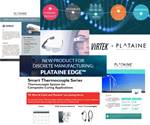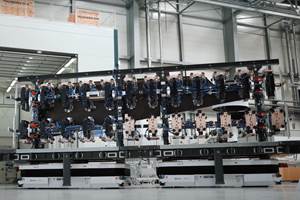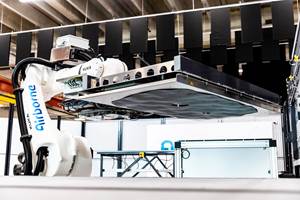Composites 4.0: Future or fad?
Columnist Dale Brosius reflects on Industry 4.0 — and, by extension, Composites 4.0 — and its future in the composites manufacturing industry.
In March 2015 I penned a column against incremental thinking in moving composites forward, proposing that we focus on developing processes with inherent measuring capability to identify materials variability in situ, and modify layup or molding conditions on the fly to improve consistency. In February 2016, I envisioned an idealized future where such upstream process sensing was sent in real time to end-to-end simulation tools that could make automated intelligent decisions and make process changes without human intervention. At the time, terms like the Industrial Internet of Things (IIoT), digital twins, machine learning and artificial intelligence were starting to enter the lexicon of manufacturing and linking to one another under the banner of “Industry 4.0.” I just wasn’t using it yet.
In April 2016 I attended the Hannover Fair in Germany, which I believe to be the center of gravity of all things Industry 4.0 each year, and saw the possibilities of this, the fourth industrial revolution. My July 2016 column, titled “Get ready for Composites 4.0,” recounted what I saw in Hannover and why composites manufacturing, perhaps more so than centuries old industries like steel and textiles, stood to benefit greatly from implementing Industry 4.0 technologies.
A quick rewind is in order here as a reminder of why we use the term Industry 4.0. The first industrial revolution was based on water and steam power, the second on the moving assembly line and electricity, and the third on robots and computers. This fourth revolution uses smart sensing, which is low in cost and ubiquitous, connected to a network, often wirelessly, where virtual copies (digital twins) make decisions based on big data and history (machine learning), cooperating with humans and other systems in real time. Products have a pedigree, called a digital thread, that is stored and can be retrieved when needed. Properly executed, Industry 4.0 offers the potential to improve product uniformity, reduce end-of-line inspection and reduce costs.
In January 2018, I pointed to IIoT — and by extension Industry 4.0 — as a technology to follow for that year. Indeed, significant progress has been made worldwide in implementing the “composites factory of the future,” as evidenced by a panel session led by CW’s Ginger Gardiner on the topic at the CW Carbon Fiber conference in Knoxville in November 2019. One of the panelists, Michael Kupke of DLR/German Aerospace Center in Augsburg, Germany, noted that “Composites 4.0 needs Research 4.0.”
I won’t debate who coined the termed “Composites 4.0,” knowing I first used it in mid-2016, but I do like that the term is being used to describe Industry 4.0 as applied to composites. While much of what has been implemented in composites production is related to materials tracking and camera-based inspection of automated tape laying (ATL) and automated fiber placement (AFP), there are test beds springing up in Europe, the U.S. and Australia to demonstrate new technologies related to composites manufacture.
In looking at what is happening, I’m reminded of previous initiatives related to manufacturing. Remember when OEMs began insisting their suppliers adopt ISO 9001, and further yet, become certified? The automotive and aerospace industries added requirements to ISO 9001, creating custom versions for their supply chains. For many smaller companies, getting ISO 9001 (and extended versions) certified was a substantial financial burden. In the end, the pain was mostly worth it and is today embedded in more than a million facilities around the world. Definitely not a fad. One group that truly fared well were the consultants that companies engaged to get through the process!
How about Six Sigma? First developed by Motorola in the 1980s, based on statistical process control techniques developed by W. Edwards Deming, it became highly popular once adopted by Jack Welch and General Electric in the mid-1990s. It introduced us to “green belts” and “black belts” and by 2000 around two-thirds of the Fortune 500 had some version of Six Sigma aimed at reducing costs and improving profits. Attempts to apply Six Sigma to sales and product development functions became overreach, stifling innovation. Today, many view Six Sigma as a fad, although some aspects remain in place on the factory floor. Consultants in Six Sigma made a lot of money, though.
Is Industry 4.0 just a fad or is it truly the future of composites manufacturing, and how will it be implemented democratically? Will big OEMs demand it of their suppliers, or will it earn its way via ROI measures? Will small companies be able to afford it? All questions yet to be answered. No doubt there will be consultants that can help…
Related Content
German UniFix project develops mobile holding fixture to enhance production efficiency of large CFRP structures
Fraunhofer IFAM and Airbus Operations in Stade demonstrate reduced manual handling and non-productive time in flow-oriented manufacturing of vertical tail plane.
Read MoreClemson Composites Center leads research in low-cost composite tooling
Innovative technology approach to use additive manufacturing and artificial intelligence to produce tools faster, at a lower cost and with less environmental impact.
Read MoreDigitizing tools for composites production
Alpex Technologies focuses on industrialization, process and part intelligence and biocomposites in its next generation of tooling systems.
Read MoreModular, robotic cells enable high-rate RTM using any material format
Airborne’s automated ply placement systems at Airbus, GKN Aerospace and Teijin Automotive Technologies aim to maximize flexibility and intelligent automation.
Read MoreRead Next
Get ready for Composites 4.0!
It might seem like science fiction, but it must be our path if we are to make composites competitive.
Read MoreComposites 4.0: digital assistants, edge computing and the future of smart factories
Plataine reviews developments and discusses where composites manufacturing is headed.
Read MoreAdvanced composites — An idealized future
A CW columnist, a composites industry consultant and the chief commercialization officer for the Institute for Advanced Composites Manufacturing Innovation (Knoxville, TN, US), Dale Brosius imagines an ideal future for our industry then challenges us to make it real.
Read More


















.jpg;maxWidth=300;quality=90)







